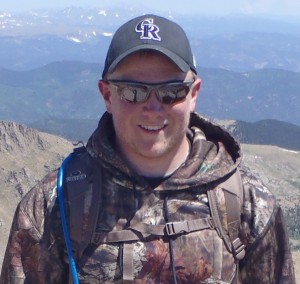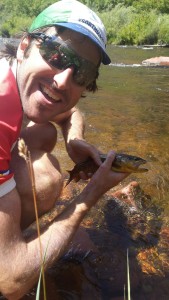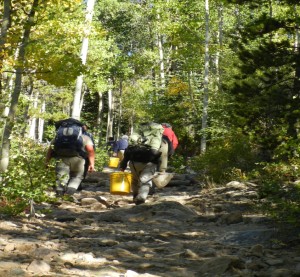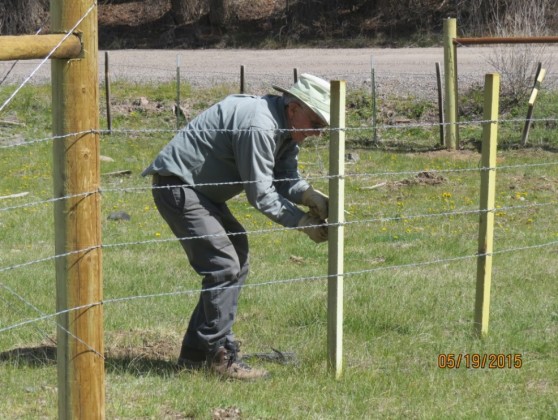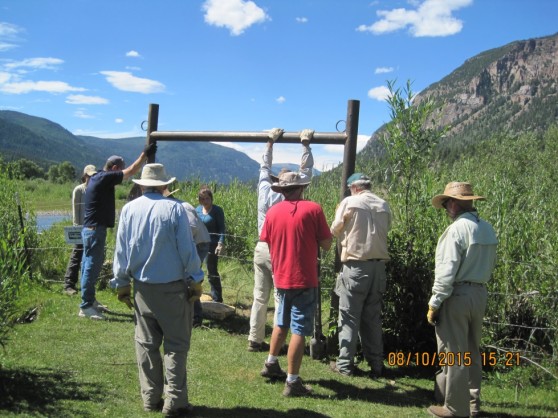The Greenway Foundation and Denver Trout Unlimited Receive $50,000 Grant from Wells Fargo-NFWF to Support their Sustainable South Platte River
Part of $100 million effort to support local environmental nonprofits
Denver, CO – 06.09.15 – The Greenway Foundation and Denver Trout Unlimited today received a $50,000 grant from the Wells Fargo Environmental Solutions for Communities grant program, funded by the Wells Fargo Foundation and administered by the National Fish and Wildlife Foundation (NFWF), to support their Sustainable South Platte River Initiative.
Established in 2012, the Wells Fargo Environmental Solutions for Communities five-year grant program has awarded $12 million to 207 grantees and funded 247 projects to date that promote conservation and environmental sustainability.
“Denver Trout Unlimited and the Greenway Foundation will work to transform current water use patterns along the South Platte River below Chatfield Reservoir into a model for cooperative water use”, stated Jeff Shoemaker, Executive Director of The Greenway Foundation and Todd Fehr, Former President of Denver Trout Unlimited. “One of the direct benefits of this collaboratively based endeavor will be the ability to provide added urban ecological restoration of this section of the River within the Denver Metro Area. Without Wells Fargo’s support, this opportunity would not be able to move forward in this manner at this time”
“This environmental grant today is an investment in our local community and will provide much-needed funding aimed at protecting the environment for our local residents,” said Ashley Grosh, Vice President, Wells Fargo Environmental Affairs “We’re proud to collaborate with The Greenway Foundation and Denver Trout Unlimited to use our financial resources, as well as the expertise of our team members, to protect and preserve a more sustainable environment for communities we serve.”
As part of Wells Fargo’s $100 million philanthropy commitment to nonprofits and universities by 2020, a $15 million, five-year relationship with NFWF was created and launched in 2012 to promote environmental stewardship across the country. The goal of the Wells Fargo-NFWF grant partnership and program is to provide grants for highly impactful projects that link economic development and community well-being to the stewardship and health of the environment. The program will fund proposals in select cities/regions (see website for full list) in the following areas:
- sustainable agriculture and forestry
- conservation of land and water resources
- restoration of urban ecosystems
- clean energy infrastructure
The Greenway Foundation and Denver Trout Unlimited were selected from among more than 450 requests submitted by local team members and nonprofits Wells Fargo identified as being in need of extra help with green revitalization projects. In April 2012, Wells Fargo released a set of environmental commitments to be achieved by 2020; including reducing the company’s environmental impact, financing the transition to a greener economy and encouraging stronger and more sustainable communities. Part of this goal includes a $100 million environmental grants commitment by 2020 to create a “greener” future for the communities they serve.
Details of the Wells Fargo Environmental Solutions for Communities grant program and a link to the 2016 application (available in September 2015) can be found at the NFWF application website: www.nfwf.org/environmentalsolutions. Projects benefiting underserved communities and encouraging volunteerism are given priority consideration. The Wells Fargo Environmental Solutions for Communities grant program is funded by the Wells Fargo Foundation to promote environmental stewardship across the country.
Since 1974, The Greenway Foundation has led efforts to:
- Reclaim the South Platte River and its tributaries from a virtual cesspool to a place of environmental and recreational pride.
- Construct more than 100 miles of hiking and biking trails
- Create 20+ parks and natural areas
- Design and build numerous whitewater boat chutes
- Vastly improve the health of the South Platte River Watershed and its habitats
- Provide environmental education to more than 60,000 school children
- Employ more than 100 teenagers in youth employment programs
- Host numerous community events, and annual volunteer river clean up days
- Help create over $500 million of green improvement to the South Platte River and its tributaries, facilitating over $15 billion in residential and commercial development throughout the Denver metro area.
Current projects include:
- SPREE (South Platte River Environment Education), including River Rangers Youth Employment and
- Greenway Leadership Corps
- River Vision Implementation Plan – South Platte River Master Plan
- PURE (Protect our Urban River Environment)
About Denver Trout Unlimited
The Denver Chapter of Trout Unlimited draws it support from the city's downtown and northern suburbs. We have a membership that is young and diverse in interests. DTU espouses and promotes the mission of Trout Unlimited to preserve, protect and restore North America's cold water fisheries and their watersheds.
This is Denver, Colorado and a river runs through it. DTU has adopted a long term goal to turn the Denver South Platte River into an asset for the city of Denver and its citizens. Our objective is to restore aquatic and riparian habitat thus making the South Platte River in Denver a recreational fishing destination for residents and visitors and a refuge for fish and wildlife. Our focus is on the river below the water line, the aquatic insects, the quality and quantity of water, the structures and bottom of the river and, of course the fish and other life forms in the water ecosystem.
One of our current goals is to work on the mechanisms that can bring a minimum flow to the Denver South Platte so that the improved aquatic environments we helped create at Carson Nature Center, Grant Frontier/ Overland Park, and soon River Run Park in Sheridan are preserved during periods of low flow stress.
The world famous Denver Trout Unlimited Pro/Am Fly Fishing Carp Slam is our major fund raising event. Proceeds are used for improving the aquatic habitat of the Denver South Platte and sponsoring Trout-in-the-Classroom sites that connect youth to our river.
Please visit www.DenverTU.org for more information about our chapter’s work and upcoming events.
About Wells Fargo & Company
Wells Fargo & Company (NYSE: WFC) is a nationwide, diversified, community-based financial services company with $1.7 trillion in assets. Founded in 1852 and headquartered in San Francisco, Wells Fargo provides banking, insurance, investments, mortgage, and consumer and commercial finance through more than 8,700 locations, 12,500 ATMs, and the internet (wellsfargo.com) and mobile banking, and has offices in 36 countries to support customers who conduct business in the global economy. With approximately 266,000 team members, Wells Fargo serves one in three households in the United States. Wells Fargo & Company was ranked No. 30 on Fortune’s 2015 rankings of America’s largest corporations. Wells Fargo’s vision is to satisfy all our customers’ financial needs and help them succeed financially. Wells Fargo perspectives are also available at Wells Fargo Blogs and Wells Fargo Stories.
 As the flows of the river are diverted and reduced, the water temperature could rise to a level threatening to trout and aquatic life- but with the 401 permit, these conditions will be monitored to ensure the fishery remains Gold. Also with lower flowers, the sediment and algae buildup cements between the cobblestone, preventing invertebrates to hatch and trout to spawn. By providing these flushing flows the sediment will be washed away and leave the cobblestone clear for aquatic habitat to survive.
As the flows of the river are diverted and reduced, the water temperature could rise to a level threatening to trout and aquatic life- but with the 401 permit, these conditions will be monitored to ensure the fishery remains Gold. Also with lower flowers, the sediment and algae buildup cements between the cobblestone, preventing invertebrates to hatch and trout to spawn. By providing these flushing flows the sediment will be washed away and leave the cobblestone clear for aquatic habitat to survive.





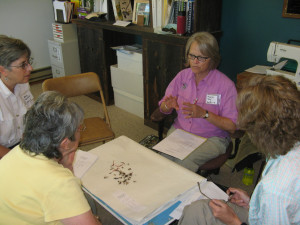
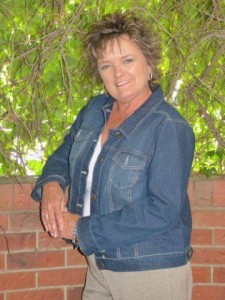 Beckie has been involved with local TU chapter activities in Montrose & Telluride the last 8 years since returning from Ghana - coordinating banquets, fund-raiser events, etc. Her and Marshall have been traveling across the country attending National TU regional and annual meetings learning all about the great work TU has going on. Her biggest impact in Colorado has been her involvement in the CTU Rendezvous by coordinating the Women's Weekend. She not only initiated this program but has been the key to its continued expansion. The ladies that connect with Beckie always leave wanting more! Come meet Beckie this year at our Rendezvous at Hotel Colorado.
Beckie has been involved with local TU chapter activities in Montrose & Telluride the last 8 years since returning from Ghana - coordinating banquets, fund-raiser events, etc. Her and Marshall have been traveling across the country attending National TU regional and annual meetings learning all about the great work TU has going on. Her biggest impact in Colorado has been her involvement in the CTU Rendezvous by coordinating the Women's Weekend. She not only initiated this program but has been the key to its continued expansion. The ladies that connect with Beckie always leave wanting more! Come meet Beckie this year at our Rendezvous at Hotel Colorado.
